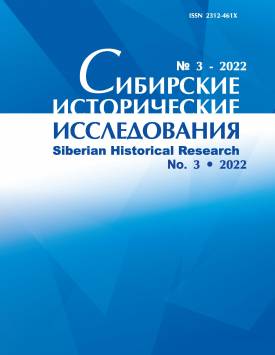The Image of the Jinn in the Saudi Cartoon ‘Ya‘rub’
The Saudi animated series “Ya‘rub” was released in 2018-2019 to become a part of a regional identity-building policy. The King Abdulaziz Foundation for Research and Archives, which commissioned the cartoon, notes that the main goal of this project was to interest the local population in the history of the region and to deepen the collective memory of their past. 11 episodes cover a vast number of characters from Qur‘anic and pre-Islamic mythology, including djinn, who mostly enjoy being second-role, but nevertheless important characters. In this article I make an attempt to analyze the image of the djinn and argue that it is based on regional perceptions and stereotypes about the world of the djinn. But at the same time, the djinn's visual embodiment in the series was influenced by the Western understanding of this “mystical” and “magical” creature. The combination of regional and Western interpretations in the image of the djinn contributes not only to the contextualization of the historical narrative, but also to building an emotional connection with the audience. The author declares no conflict of interests.
Keywords
visual culture,
collective narrative,
historical heritage,
political memory,
jinnAuthors
| Slepukhina Olga P. | Peter the Great Museum of Anthropology and Ethnography (Kunstkamera) | olya2s2s@mail.ru |
Всего: 1
References
Tosh J. The pursuit of history: aims, methods, and new directions in the study of modern history. 3d ed. London: Longman Press, 2002.
Samin N. Our Ancestors, Our Heroes: Saudi Tribal Campaigns to Suppress Historical Docudramas // British Journal of Middle Eastern Studies. 2014. Vol. 41 (3). P. 266-286.
De Rivera J.H., Sarbin T.R. Believed-in Imaginings: The Narrative Construction of Reality. Washington, DC: American Psychological Associations Press, 1998.
Rodionov M. The jinn in Hadramawt society in the last century // Proceedings of the Seminar for Arabian Studies: 38; Papers from the forty-first meeting of the Seminar for Arabian Studies held in London, 19-21 July 2007 (2008). P. 277-281.
De Rivera J. Emotion and the Formation of Social identities // Collective emotions: Perspectives from psychology, philosophy, and sociology / eds. by C. von Scheve, M. Salmela. Oxford University Press, 2014. P. 217-231.
Peterson M.A. The jinn and the computer: Consumption and identity in Arabic children’s magazines // Childhood. 2005. Vol. 12 (2). P. 177-200.
Peterson M.A. From Jinn to Genies: Intertextuality, Media, and the Making of Global Folklore // Folklore/Cinema: Popular Film as Vernacular Culture / eds. by S.R. Sherman, M.J. Koven. University Press of Colorado, 2007. P. 93-112.
Pernau M. Feeling communities: introduction // The Indian Economic and Social History Review. 2017. Vol. 54 (1). P. 1-20.
Padwick C. Notes on the jinn and the ghoul in the peasant mind of Lower Egypt // Bulletin of the School of Oriental Studies (University of London). 1924. Vol. 3 (3). P. 421-446.
McDowell S. Heritage, Memory and Identity // The Ashgate research companion to heritage and identity / Eds. Brian Graham and Peter Howard. Abingdon: Routledge, 2008. P. 37-53.
Lebling R. Legends of the Fire Spirits: Jinn and Genies from Arabia to Zanzibar. London: I.B. Tauris, 2015.
King Abdulaziz Foundation for Research and Archives (Darah). URL: https://darah.org.sa/index.php/media-library/st-and-rep/dignitaries/188-2019-07-14-05-40-21 (Access: 28.02.2022).
al-Iṣfāhānī ‘Abd al-Ḥasan. Kitāb al-Bulhān. URL: https://archive.org/details/KitabAl-Bulhan/page/n21/mode/2up (Access: 28.02.2022).
al-Fīfī Ziād Maḥkama sa‘ūdīyya tubarriu’-l-djinn wa tusadjdjinu ḳāḍīyyan ‘ishrīn ‘āman bituhmat al-fasād. Independent Arabia, 27.10.2019. URL: https://clck.ru/vk4Hw (Access: 28.02.2022).
Doumato E.A. Getting God's Ear. Women, Islam and Healing in Saudi Arabia and the Gulf. New York: Columbia University Press, 2000.
El-Zein A. Islam, Arabs, and the Intelligent World of the Jinn (Contemporary Issues in the Middle East). New York: Syracuse University Press, 2009.
Carboni S. The 'Book of Surprises' (Kitab al-bulhan) of the Bodleian Library // THE LA TROBE JOURNAL. State Library of Victoria Foundation. 2013. Vol. 91. P. 22-34.
Canaan T. The Decipherment of Arabic Talismans. Berytus 4 (Beirut, 1937) and Berytus 5 (Beirut, 1938) // reprinted in Magic and Divination in Early Islam / ed. E. Savage-Smith Emilie. Aldershot, UK: Ashgate Publishing, 2004. P. 125-177.
al-Anṣārī ʿAbd al-Raḥmān Qaryat al-Fau, a portrait of pre-Islamic civilisation in Saudi Arabia. [Riyadh]: University of Riyadh, 1982.
Лейн Э.В. Арабский мир в эпоху «Тысячи и одной ночи». М.: Центрполиграф, 2009.
Налич Т. Ангелы и другие сверхъестественные существа в исламе. М.: Знак, 2009.
Ассман А. Длинная тень прошлого. Мемориальная культура и историческая политика. М.: Новое литературное обозрение, 2014.

